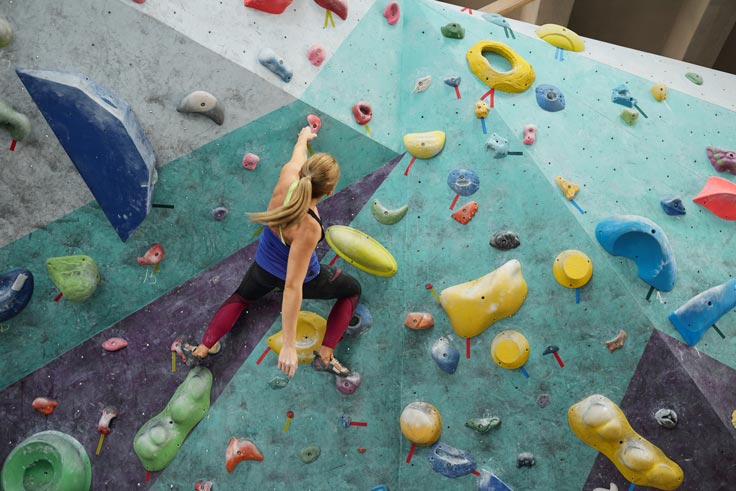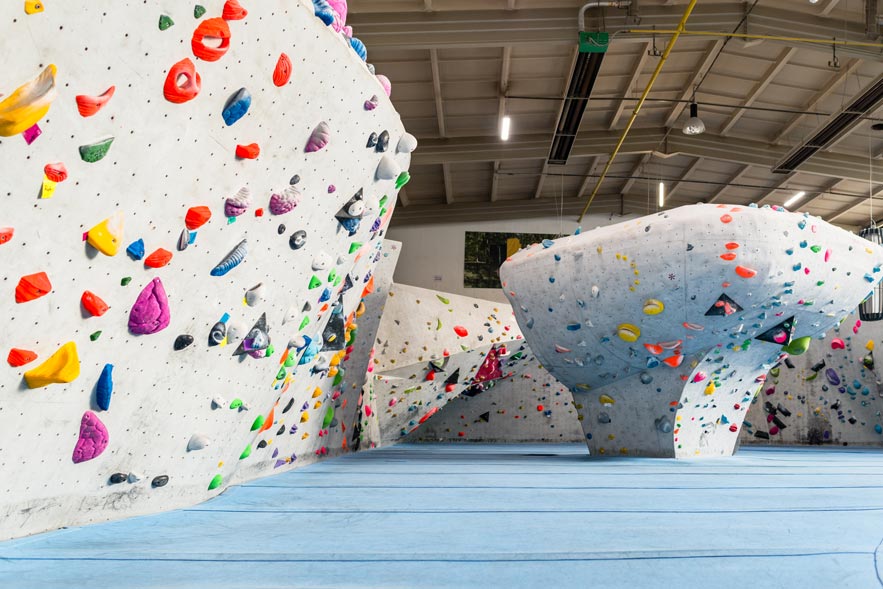Are you looking for a bouldering gym where you can start practicing the sport of bouldering? Or maybe you have recently moved, and are looking for a new bouldering facility? Unsure where to get started? We’ve got you! This article will help you pick the best bouldering gym that meets your goals and preferences.
📚 This article is part of a wider guide: The Basics of Indoor Bouldering.
Phase 1: Evaluation
What are your options?
Depending on where you live, you might have a couple of prospects for indoor bouldering gyms. The closest one is ideal, but that doesn’t mean it’s the best one. And opting for a subscription there, without looking at other prospects, might be a regrettable move.
The first step in determining which bouldering gym is right for you is to evaluate all the options. Grab a piece of paper or open an excel sheet and write down all your options. A quick google search should reveal the bouldering gyms in your area.
Got it? Great. Let’s continue.
Your Goals and Preferences
Your ideal bouldering gym is one that fits all your goals and preferences. The following questions will help you figure out your preferences.
What is your skill level?
Some bouldering gyms are more beginner-friendly than others. It’s important to understand what your current skill level is so that you can evaluate how well the prospects cater to those.
What are your fitness goals?
Sometimes bouldering gyms are much more than simple climbing facilities. Most bouldering halls have training areas that include system boards, hangboards, pull-up bars, etc. Some climbing gyms take it to another level and have weights, machines, and other equipment available that could replace a fitness gym subscription.
If you are looking for more than just climbing, it’s worth it to take this into consideration and find a bouldering hall that caters to both climbing and fitness.
Do you require extras (e.g. classes, workshops)
Some bouldering gyms are mere training facilities, while others are communities that host frequent workshops, give you access to a team of coaches (against payment), host yoga classes, and so on.
Depending on your preferences, these extras might be worth a higher subscription cost.
What kind of membership are you looking for?
How much are you willing to pay for a membership? And what kind of membership are you looking for? Monthly, annual, etc.
Phase 2: Visiting the prospects

Evaluate the Bouldering gym’s Facilities and Equipment
When picking a bouldering gym, it’s important to evaluate the facilities and equipment to ensure they meet your needs. Some key factors to consider:
Climbing surface
Bouldering gyms come in vastly different sizes. I’ve visited climbing megacomplexes and cozy garage-sized gyms. You likely don’t need something like the former, but the latter might not be enough to satisfy your needs. When looking at the climbing surface, we want to ensure that there is enough space to get the most out of our subscription.
A smaller bouldering gym might leave you bored once you have completed all the boulder problems within your level.
Climbing Holds and routes
Good holds and routes are crucial when choosing a bouldering gym. I’d say even more important than the surface of a climbing gym. I favor small bouldering gyms that have good holds, plenty of problems, plenty of resets, and passionate setters over big venues that lack all of those.
I’ve definitely been to commercial gyms that felt like they uninspired boulder problems, had empty-looking walls, and lacked resets. And these facilities are often much more expensive than a non-commercial climbing gym.
Empty walls with big fancy holds are a huge red flag for me as this will mean you run out of problems super quickly. These gyms are fun for casual visits, not subscriptions!
P.s. Good gyms reset at least one wall every week to allow their subscribers to climb new boulders on a weekly basis.
Pay attention to: hold types and variety, the density of boulder problems on the wall, and how often the walls are being reset.
Wall angles and height
What I love about bouldering gyms is that they each have their own individually designed walls. You’ll never find a bouldering gym with the same walls as another, it’s great!
When looking at the walls, you should pay attention to the angles and heights. Good bouldering gyms have enough vertical, slab, and overhang walls at many different angles. Sometimes the walls are designed by specialized companies such as Walltopia and in these cases, the walls are always phenomenal. But even in-house wall designs can be great if there is enough variety and creativity.
Until now, I’ve only ever visited one bouldering hall that had super disappointing walls. This gym, in particular, consisted of about 70% vertical walls. I don’t know what went into their heads when they designed the walls, it’s so bland and makes all the sets super repetitive!
the mats
Safety is a priority in a sport like indoor bouldering and the number one safety precaution that gyms should have is good matting. Although the mats at bouldering gyms should qualify for safety standards, it doesn’t hurt to be picky and thoroughly test the equipment.
Furthermore, every bouldering gym has a different type of mat. Some might be too firm, or too soft for your preferences. Ensure that the bouldering gym you visit has a comfortable mat for you to land on. If you aren’t comfortable or don’t feel safe, you will never be able to climb at your limit.
training areas
As aforementioned, most bouldering gyms have at least a small training area where climbers can warm up using a hangboard, do their stretches, and maybe do some strength exercises.
Check out the training area during your visit to ensure they fit your needs. These needs are different for everyone and also depend on your climbing level. If you are new, you might not even require a training area. But if you’re more experienced, you are probably going to want to have access to training equipment such as hangboards, campus boards, and maybe tension boards.
My personal preference goes to the MoonBoard. Sadly this is not available in my area, but having regular access to one would definitely sway that bouldering gym in my favor.
Consider the atmosphere and community of the bouldering gym
Staff
Friendly staff members are important to have a nice experience if you’re going to spend multiple climbing sessions per week at the bouldering gym. If they never smile, look like they don’t enjoy their jobs, and aren’t helpful, you’re going to regret your choice at some point.
I haven’t had too many bad experiences as most staff members tend to be passionate climbers or even gym owners, but I have run into some bad apples at commercial facilities.
Vibe and culture
When evaluating bouldering gyms, it’s crucial to take into account the gym’s overall vibe and culture. This includes factors such as the friendliness of the staff and other members, the music and ambiance, and the general atmosphere. Some bouldering gyms are more relaxed and laid-back, while others may be more intense and competitive.
It’s also important to consider the gym’s values. Do they prioritize inclusivity and diversity? Do they have programs or initiatives that promote community outreach and social responsibility? These factors can influence the overall culture of the gym and may be important considerations for some individuals.
Overall, it’s important to choose a gym with a vibe and culture that aligns with your personal preferences and goals. A positive and welcoming environment can greatly enhance your overall bouldering experience and help you stay motivated and engaged in your climbing practice.
Size and density of the crowd
Bouldering gyms can get pretty crowded. This isn’t necessarily a bad thing as climbers make the place feel alive and create the community around it, but there is definitely a breaking point. On the other side, a bouldering hall hat that lacks climbers is also a very dull affair.
I once visited a huge new bouldering hall in a bigger entertainment center. From the pictures I saw online, the place looked phenomenal. But once there, it felt very liminal. The gym was empty, on a Saturday. Furthermore, it had no staff and instead used QR codes to enter. I’ve never felt so alone. I thought, if I hurt myself right here, no one would find me for hours, possibly days. As if I were the last man alive in a post-apocalyptic world. Pass!
Look for something in between. A bouldering gym shouldn’t be empty, but you shouldn’t have to wait in line for every boulder problem either.
Opportunity to meet new people
Another important consideration when choosing a bouldering gym is the opportunity to meet new people. Bouldering is a social activity that can be enjoyed with friends or as a way to make new ones. A gym that fosters a friendly and welcoming community can provide an opportunity to connect with like-minded individuals who share a passion for climbing.
Some gyms are part of a climbing club, offer social events, and host competitions, which can be a good way to meet new people. These types of gyms also tend to have a better community of friendly members who are also welcoming toward new people.
Ultimately, choosing a gym with a welcoming and inclusive community can greatly enhance your overall bouldering experience and make it a more enjoyable and social activity.
Judge the location and accessibility of the Boulder Gym
When choosing a bouldering gym, it’s important to research the location and accessibility of the gym. Here are some key factors to consider:
Distance and Transportation
Depending on where you live, you’ll want to choose a bouldering gym that is close to home or easily accessible. You should factor in travel costs when deciding on your boulder gym.
Some questions to consider:
- Can the gym be accessed by public transport?
- What is the cost of public transport?
- Can the gym be accessed by bike?
- Is the gym within driving distance?
- How much would it cost to drive to the gym?
Parking and bike racks
If you plan to drive or bike to the boulder gym, you’ll want to ensure that there are adequate parking and bike racks available. Also, take in mind the cost of parking. Some climbing gyms might have free parking on-site while others might require you to park elsewhere for an hourly fee.
Surrounding areas and amenities
What is the surrounding area of the boulder gym like? Is it located in a safe area? Not too far removed from restaurants where you could grab a bite after your climb? Consider the surrounding area when evaluating the location of the gym.
Choosing a gym that is located in a convenient and accessible area will make it easier to incorporate bouldering into a regular routine.
Conclusion
Hopefully, this article helped you prepare to choose the right bouldering gym for your needs. Don’t just settle for the closest one to you, settle for a climbing gym that makes you feel safe and welcome. Opt for a bouldering gym with good transportation, a nice community, friendly staff members, an impeccable atmosphere, diversity in their walls and angles, and good route-setting.
